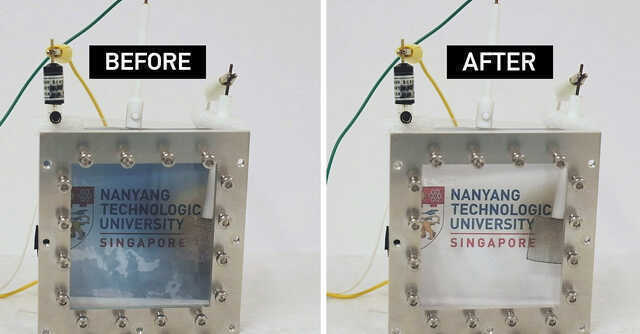
Researchers build smart windows that can resist heat without reducing visibility


A team of researchers at Nanyang Technological University, Singapore (NTU) has developed a “smart” window material that claims to be able to resist heat from sunlight – without reducing visibility.
The window in question uses a newly developed energy saving material, which helps the electrochromic window prevent heat from filtering indoor, without needing to dim the glass that is seen typically in conventional electrochromic windows.
The new material works at the flick of a switch. Once turned on, the material is capable of blocking infrared radiation.

The technical description by the research team states, “The new material has a specifically designed nanostructure and comprises advanced materials like titanium dioxide (TiO2), tungsten trioxide (WO3), neodymium-Niobium (Nd-Nb), and tin (IV) oxide (SnO2).
The composite material is intended to be coated onto glass window panels, and when activated by electricity, users would be able to ‘switch on and off’ the infrared radiation transmission through the window.”
Published in the journal ACS Omega, the aforementioned material can block 70 percent of incident infrared radiation, while allowing 90 percent of the incident light to pass through the window surface. The researchers also claimed that the new material is considerably more durable as well as a result of being easy to make, and says that in comparison to conventional electrochromic windows, is 30 percent more efficient in reducing incident heat.

Alfred Tok, associate professor of the NTU School of Material Science and Engineering, who led the research, says, “By incorporating the specially designed nanostructure, we enabled the material to react in a ‘selective’ manner, blocking near infrared radiation while still allowing most of the visible light to pass through whenever our electrochromic window is switched on.
The choice of advanced materials also helped improve the performance, stability and durability of the smart window.”
The product combines with a patented switch design from NTU as well, which can be used to enable the electrochromic process of the new window material. Shlomo Magdassi, professor at Institute of Chemistry at the Hebrew University of Jerusalem, and co-author of the research, affirmed that the material can potentially play a key role in improving the performance of green commercial buildings – creating significant power savings due to higher cooling efficiency.

“The research outcome is expected to enable fabrication of unique windows that will result in energy savings,” he said.
